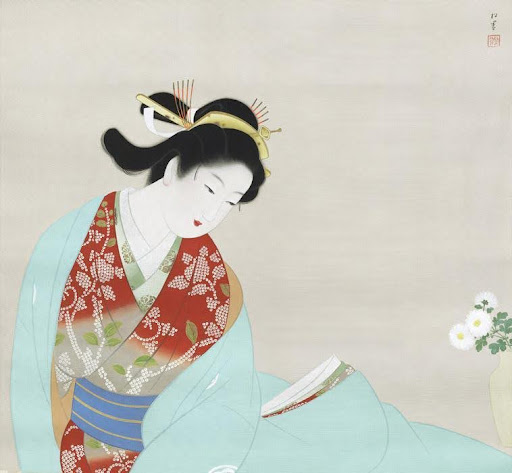3. 菊寿(Kikuju)
菊に託した高雅と長寿の美学

《菊寿》(きくじゅ)は、昭和初期〜中期(1930〜40年代)に描かれた晩年の彼女が到達した「真・善・美」の理念の集大成ともいえる作品。描かれた女性は、繊細な紅白の花模様が施された着物に身を包み、控えめながらも凛とした表情を浮かべている。傍らに生けられた白菊は、古来より「高貴」「潔白」「長寿」の象徴であり、高い格式を意味する。「菊寿」には、文字通り“菊の長寿”という意味が込められ、女性の精神的美しさと命の尊厳を重ね合わせる意図が読み取れる。「生の尊さ」と「美の精神性」を融合させた、松園ならではの思想的絵画あり、昭和期の文化的状況における貴重な記録としても高く評価されている。
Kikuju (Making a Wish for a Long Life on Chrysanthemums)
An aesthetic of elegance and longevity embodied in chrysanthemums
Kikuju, painted in the early to mid-Showa period (1930s–1940s), is considered a culmination of Uemura’s lifelong pursuit of truth, goodness, and beauty. The woman depicted wears a kimono adorned with delicate red and white floral patterns, her expression modest yet dignified.
Beside her, a vase of white chrysanthemums—symbols of nobility, purity, and longevity in Japanese tradition—adds a sense of refined formality. The title Kikuju, literally meaning “chrysanthemum longevity,” reflects Uemura’s intent to intertwine spiritual beauty with the dignity of life.
This work embodies her philosophical vision, fusing reverence for life with the spiritual essence of beauty. It stands as a culturally significant record of the Showa era and a testament to Uemura’s mature artistic ideals.
お問い合わせ
〒154-0024 東京都世田谷区三軒茶屋1-39-7